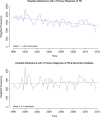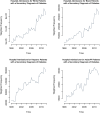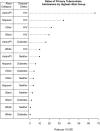Diabetes as an increasingly common comorbidity among patient hospitalizations for tuberculosis in the USA
- PMID: 27843553
- PMCID: PMC5073569
- DOI: 10.1136/bmjdrc-2016-000268
Diabetes as an increasingly common comorbidity among patient hospitalizations for tuberculosis in the USA
Abstract
Objective: Diabetes is a risk factor for active tuberculosis (TB). The purpose of this paper was to estimate the risk of hospitalization for TB with and without a secondary diagnosis of diabetes in groups with different ethnic backgrounds.
Research design and methods: We used the Nationwide Inpatient Sample from 1998 to 2011, identifying all patients with a primary diagnosis of TB and/or a secondary diagnosis of diabetes (type 1 or type 2) or HIV. Next, we performed logistic regression to investigate the association of diabetes status, HIV status, and race (and the interaction of diabetes and race) with the risk of hospitalization with a primary diagnosis of TB. We also included a time covariate, to determine whether potential risk factors changed during the study period.
Results: Controlling for HIV status, diabetes did not increase the odds of TB in white and black patients. However, in Hispanic and Asian/Pacific Islander patients, diabetes increased the odds of TB by a factor of 1.7 (95% CI 1.51 to 1.83). Asian/Pacific Islanders who had diabetes but not HIV experienced 26.4 (95% CI 23.1 to 30.1) times the odds of TB relative to the white males without diabetes or HIV. In addition, the percent of TB cases that belong to these high-risk groups (Asian/Pacific Islander/Hispanic diabetics) has more than doubled from 4.6% in 1998 to 9.6% in 2011.
Conclusions: In specific demographic groups, diabetes was a strong risk factor for hospital admissions for TB.
Keywords: Epidemiology; Glycemic Control; Tuberculosis.
Conflict of interest statement
Conflicts of Interest: None declared.
Figures




Similar articles
-
Hospitalizations for tuberculosis in the United States in 2000: predictors of in-hospital mortality.Chest. 2004 Oct;126(4):1079-86. doi: 10.1378/chest.126.4.1079. Chest. 2004. PMID: 15486367
-
Tuberculosis during pregnancy in the United States: Racial/ethnic disparities in pregnancy complications and in-hospital death.PLoS One. 2018 Mar 26;13(3):e0194836. doi: 10.1371/journal.pone.0194836. eCollection 2018. PLoS One. 2018. PMID: 29579086 Free PMC article.
-
The epidemiology of spinal tuberculosis in the United States: an analysis of 2002-2011 data.J Neurosurg Spine. 2017 Apr;26(4):507-512. doi: 10.3171/2016.9.SPINE16174. Epub 2016 Dec 16. J Neurosurg Spine. 2017. PMID: 27982765
-
Isoniazid-monoresistant tuberculosis in the United States, 1993 to 2003.Arch Intern Med. 2008 Oct 13;168(18):1984-92. doi: 10.1001/archinte.168.18.1984. Arch Intern Med. 2008. PMID: 18852399
-
Determinants of treatment-related paradoxical reactions during anti-tuberculosis therapy: a case control study.BMC Infect Dis. 2016 Sep 6;16(1):479. doi: 10.1186/s12879-016-1816-4. BMC Infect Dis. 2016. PMID: 27600661 Free PMC article.
Cited by
-
Impact of diabetes mellitus on tuberculosis prevention, diagnosis, and treatment from an immunologic perspective.Exploration (Beijing). 2024 Mar 5;4(5):20230138. doi: 10.1002/EXP.20230138. eCollection 2024 Oct. Exploration (Beijing). 2024. PMID: 39439490 Free PMC article. Review.
-
Immunological Impacts of Diabetes on the Susceptibility of Mycobacterium tuberculosis.J Immunol Res. 2019 Sep 9;2019:6196532. doi: 10.1155/2019/6196532. eCollection 2019. J Immunol Res. 2019. PMID: 31583258 Free PMC article. Review.
References
-
- Centers for Disease Control and Prevention. Tuberculosis (TB) data and statistics. http://www.cdc.gov/tb/statistics/default.htm (cited 4 Oct 2015).
-
- World Health Organization. Global tuberculosis report, 2015. http://www.who.int/tb/publications/global_report/en/ (cited 6 Jul 2016).
Grants and funding
LinkOut - more resources
Full Text Sources
Other Literature Sources
